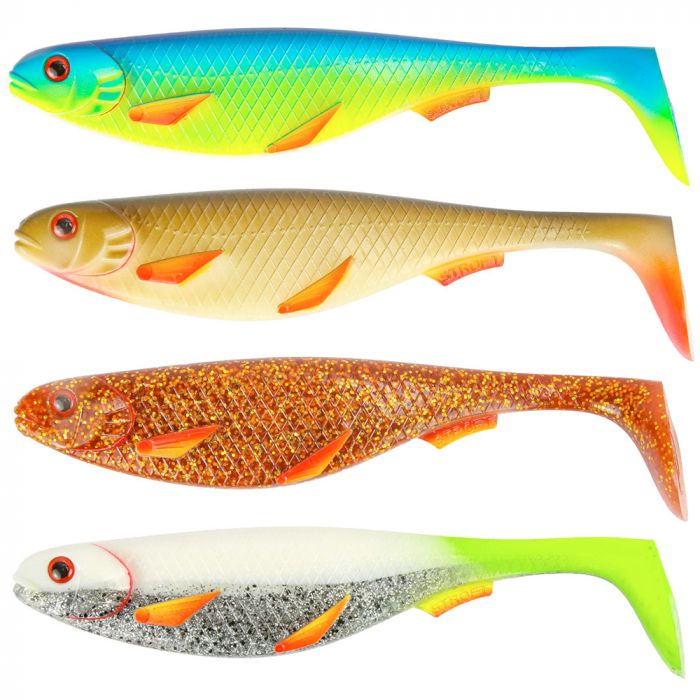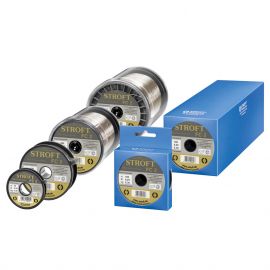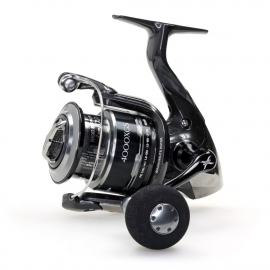The movement behaviour (including the flow generation)
Stroft's many tests show that, in contrast to the colour design, there is obviously only one single optimal movement behaviour of a rubber fish, which repeatedly provokes the predator to bite with the highest possible probability. This is also confirmed by numerous anglers and predatory fish experts. It is the movement and swimming behaviour of a naturally sick fish. Rubber fish that show such a movement and swimming behaviour are the most catchable. This is not surprising, because ailing or damaged fish are the main prey of predatory fish. These rubber fishes are characterized by two striking movement patterns: Firstly, a relatively strong lateral (non-rotating) deflection of the tail fin, and secondly, an anticipatory movement of the tail fin, which is passed on via the trunk, results in a counter-rotating movement of the head. This movement behaviour (when using a suitable jig head) is achieved by the appropriate physical design of the rubber fish, especially the tail fin, and by the hardness (flexibility) of the material which is adapted to it.
Significantly less catchable are lifelike replicas of rubber fish (roach, pike, etc.), at least when these rubber fish are usually somewhat sluggish, not reflecting the actual swimming behaviour of sick natural fish. Likewise, rubber fish that are excessively active (e.g. with a helically turning tail fin) are less catchable. Finally it was found that a special and additional bite stimulus is obviously sent when the gummy fish is already designed in the front area in such a way that turbulent currents are already generated here. Most rubber fish are relatively smooth in the front area up to the caudal fin, so that a laminar flow prevails here, from which no pressure wave stimuli emanate. Only the caudal fin generates a turbulent flow. In summary, rubber fishes should therefore show the above described movement behaviour of a sick, natural fish in every size and also generate a turbulent flow already in the front area. Stroft has implemented these findings constructively. The STROFT PREDATOR shows the optimal movement behaviour and is equipped with so-called "tear-off edges" in the front and middle area, which generate turbulent currents and thus send additional biting stimuli. In the STROFT PREDATOR, the first tear-off edges are formed on both sides of the head by gill covers that protrude relatively far. Two further tear-off edges are formed by pectoral fins protruding on both sides and another two tear-off edges are formed by a pair of protruding ventral fins. The STROFT PREDATOR has a trapezoidally shaped scaly structure which generates additional micro-turbulent flows. And the oscillating tail fin of the STROFT PREDATOR optimizes the stimulus transmission to the predator.
The colour design
Here we can only confirm the experience of numerous anglers and experts: Colour changes and colour variations are the order of the day! There seems to be a tendency: weak light and poor visibility in the water require rather conspicuous, bright colours - sunshine and clear water rather overcast and darker colours. But this is not always the case, sometimes it is exactly the other way round. What is more certain is that the probability of a bite decreases the more often a gummy fish with the same colouring is used in the same water. This is why those anglers are generally more successful who use colour variants more often. Obviously there is a kind of "habituation effect" among predatory fish. This is exactly what we have experienced. Often it was enough to just put "splashes of colour", e.g. by colouring the fins or other areas. We have taken this into account with the STROFT Predator and, for example, have designed the implied inside of the gills in realistic red and given the pectoral and ventral fins a red colour gradient. This gives the STROFT Predator additional bite stimulus.
In order to eliminate the above mentioned "habituation effect" we recommend that you make additional colour changes yourself if necessary. This can be done with waterproof markers or paint. This is how you make the STROFT PREDATOR your most durable lure!







